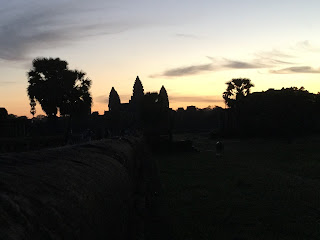 | |
| Cambodia |
The paperwork was so streamlined that our passports were collected and processed as a group. The departure date stamp was on our passport before we actually were in the airport on the last day. They have all the form and appearance of an international formality, but much of the meaning, like departure stamp, has been lost in the process. Similarly, gratuities for the tour leader, local tour guide, bus driver, and bell boys all have fixed prices and are handled as a group. These fees are not truly voluntary with this practice. The lodging accommodation was excellent with all four nights at Angkor Palace Spa and Resort [2].
 |
| Angkor Wat and Tuk Tuk Car |
 | |
| Angkor Wat at Dawn |
 |
| Angkor Wat and its Reflection |
 | |
| Tree Grown On Top of a Temple Gate |
 |
| Bas Relief with Hands Flapping to Fly |
I am not an art person per se. But the tour guide was nice enough to explain many special features of the bas reliefs seen in many temples. I enjoyed very much this animated bas relief with its hands flapping to fly up.
 |
| Unfinished Temple with Narrow and High Steps |
I enjoyed the strenuous climbs of one unfinished temple. During its construction, the temple was struck by lightening, which was viewed as a bad omen and thus never finished. This temple has no carvings, statues, and other decorations. It has very narrow and high steps and make the climb a little challenging.

Tonle Sap means "Freshwater Lake" in the Cambodian language. It is a huge lake about 12,000 square kilometers in area during monsoon season. That is 1/3 of the size of the Taiwan island.
 |
| Police Station Floating on Tonle Sap |
 |
| Coconut Drink Treat on a Hot Day |
 |
| Roadside Elephant Ride |
The elephants were very much part of the ancient Cambodia history and culture. I only saw a few of them in this trip. This photo shows a roadside opportunity for people to ride on an elephant. The local tour guide explained that much was lost in this war-torn country, and there is not much to be spared or left with when more than 1/4 of the human population was killed. You can watch the award-winning movie "The Killing Fields" that depicted the horrors done by the Khmer Rouge [6].
 |
| A simple two-room CTEP school |
The schools teach computer skills, the English language, and the Chinese language, with the ultimate goal to educate the students enough for the many industries in Cambodia.
The picture shown here is a simple two-classroom structure attached to one of the local elementary schools near Siem Reap.
 | |
| CTEP class/exam in session |
The project founder and director is one of my acquaintances in my National Taiwan University days forty years ago. I find his personal vision and persuasion in doing this work at the grass-root level very convincing and meaningful. He has a good model going for this war-torn country that regained peace only as recently as 1998.
References:
[1] Cambodia - https://en.wikipedia.org/wiki/Cambodia
[2] Angkor Palace Spa and Resort - http://www.angkorpalaceresort.com/
[3] Angkor Wat - https://en.wikipedia.org/wiki/Angkor_Wat
[4] Angkor Thom - https://en.wikipedia.org/wiki/Angkor_Thom
[5] Tonle Sap - https://en.wikipedia.org/wiki/Tonl%C3%A9_Sap
[6] The Killing Fields - https://en.wikipedia.org/wiki/The_Killing_Fields_(film)
[7] CTEP - http://camtw.com.tw/

1 comment:
Setiap Hari ada bonus menarik dari kami | www.sabungayam.pw | WA : +6281377055002 | BBM : D1A1E6DF | BOLAVITA
Post a Comment